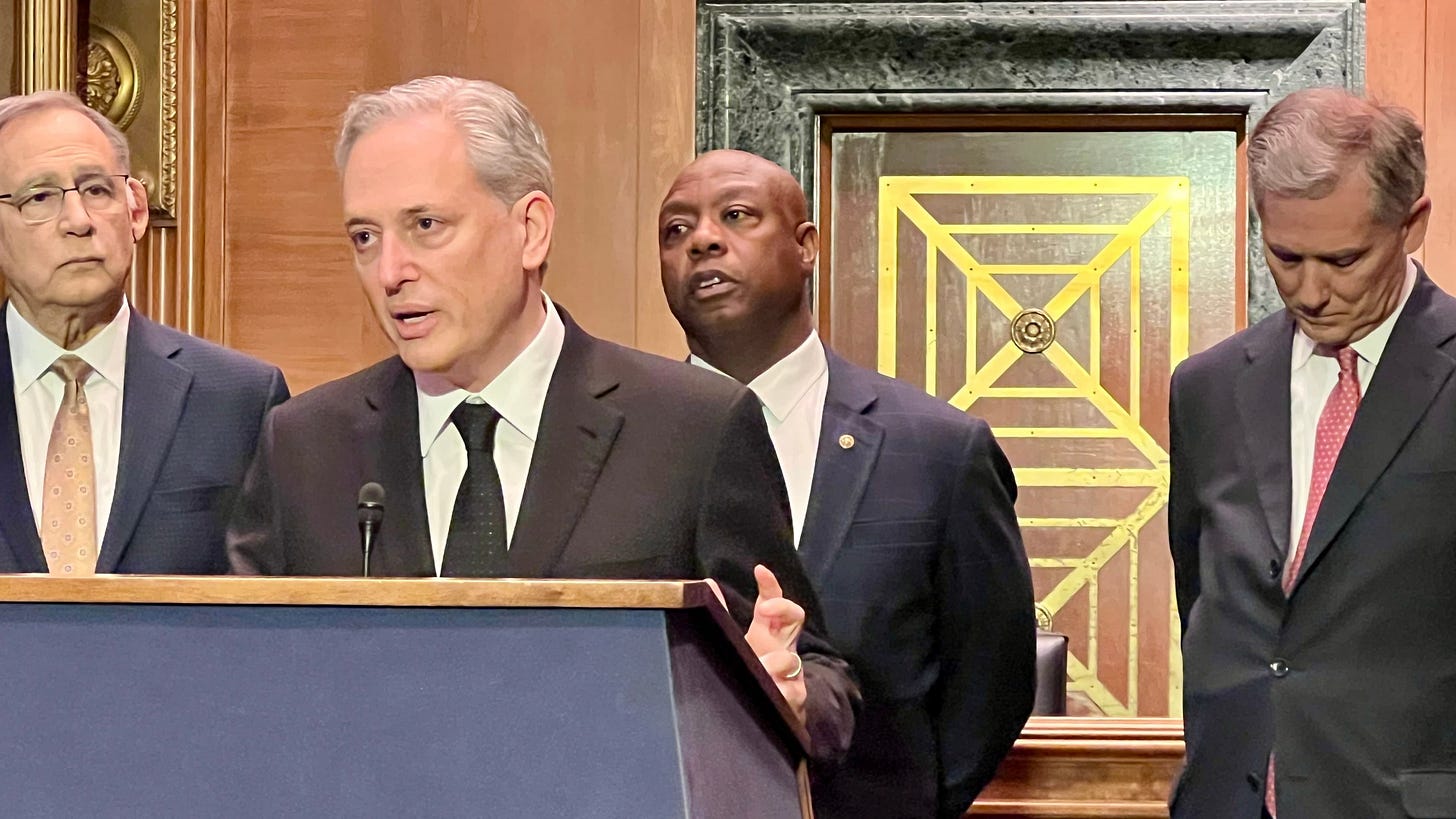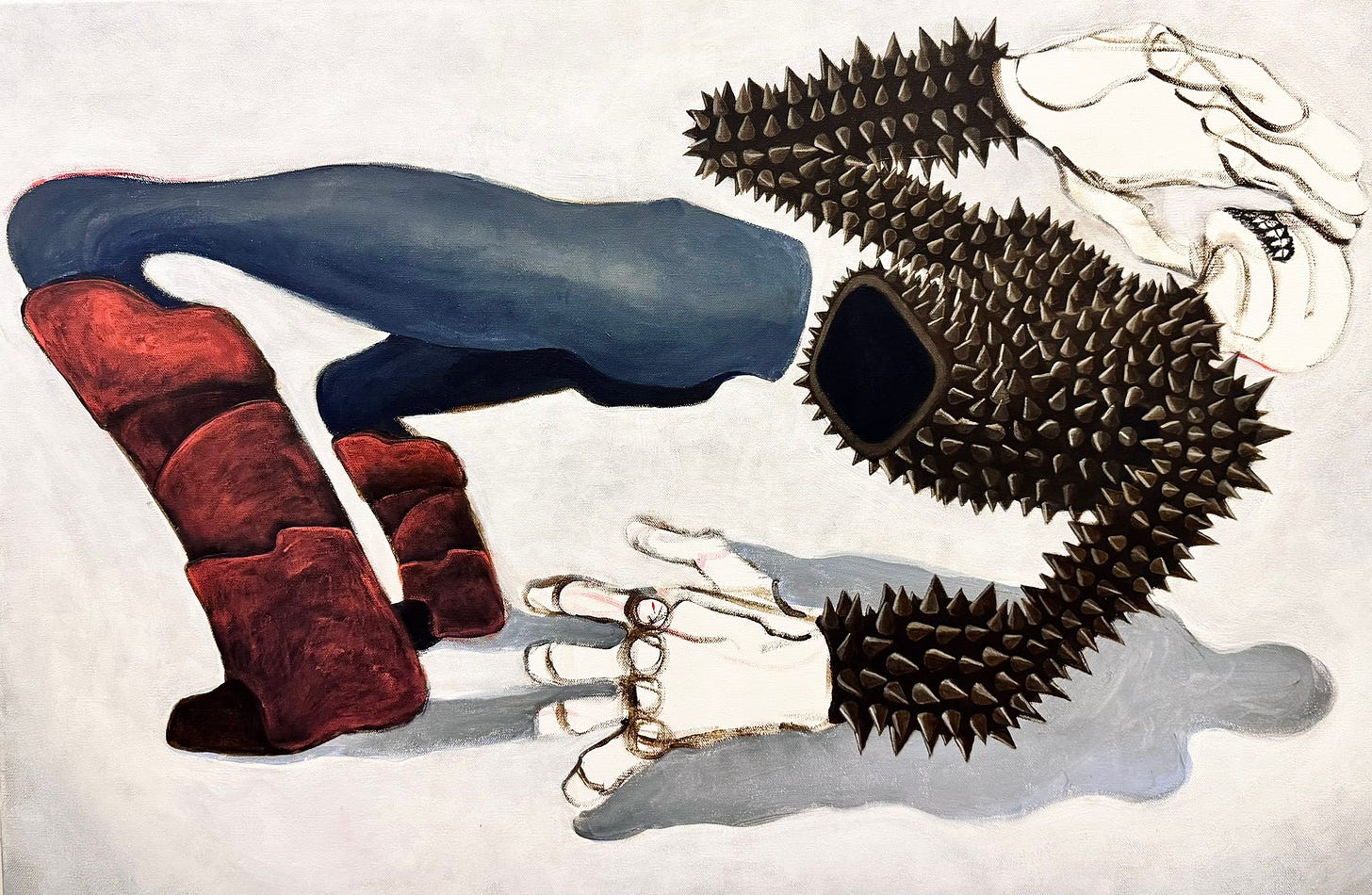Don’t miss an edition: hit this li’l ☝️☝️ subscribe button ☝️☝️ right up here.
In This Week’s Round-Up:
The U.S. Gov’t finally addresses crypto: an attempt at Stablecoin Regulations, Crypto Czar David Sacks’ professed golden age,
Google on using AI for warfare: “Now it’s okay!” Plus, a Deepseek deep-dive.
Our attention is being subverted: more monkey pictures, less Parkinson’s research efforts?
Okay, Let’s Get On With It
The Crypto Art Side:

Admittedly, this graphic is dope. And that goes for nearly all the art Mr. Sam Spratt has produced in his crypto art tenure, at least that which I’m aware of. Listen, I love painting. I love painters. I love digital art. I love a performance. I love creativity. I love lore. I love world-building. I love skill and execution, especially married together. Spratt has proven himself adept at all of that; more than adept, his extended Luci universe is a masterclass in conceptualism, community-building, and provoking thought.
Spratt’s latest addition to his “Luci Saga” (which includes a number of chaptered, 1-of-1 Luci paintings, 1/1/50 Skulls of Luci, and the mass-participatory Monument Game) is Masquerade, an invitation-only, seven-part art game of some sort, which includes 1/1/613 artworks (613 being the total number of possible Mitzvot in the Torah, for what it’s worth) and a way to “gather in the participatory jungle to Observe, Discuss, Revise and reveal our nature to one another in a common space.” Spratt certainly knows how to use ambiguity to drum-up interest. I am sure that participants in his game, as with the Monument Game before it, will find themselves challenged and well-rewarded. They certainly seem to believe so.
But —man, oh man— I’ve become so tired of market mechanics meant to exclude. And more than exclude, to revel in that exclusion. The visual art market at large is inherently exclusionary. Unlike film, literature, or music, which reaches its heights only through mass experience and ownership, visual art is inherently scarce. Value congregated in only few assets. Scarcity breeds all the things an art movement trafficks in: prestige, influence, valuation, etc.
The actual effect of this scarcity, especially when dressed-up in masterful marketing, is akin to the popular kid’s table in a school lunchroom. It’s never just about being popular, it’s about communicating one’s popularity to the unpopular. Spratt is one of the space’s most financially and socially successful artists, and by all appearances, a good guy (though charges of cultural appropriation in his very African-ized artwork are, in my opinion, valid). But these invitations of his weren’t just sent to mailboxes. They weren’t reserved for their participants. They were —in mechanism and intent— meant to be highly highly public.
Every iota of this performance is meant to inspire FOMO. Financially that makes sense, given that half-or-so of his 613 new artworks are available to various parties for 2.5 ETH, or roughly ~$7,000, each. The effect, however, is enervating. Seemingly hundreds of posts by people who are just so humbled, so grateful, so excited to be a part of this game. This life-changing game. This era-defining game. This unmissable game put on by a genius! A mastermind! A revelation! Spratt has built a cult of personality around himself, but his cult’s public posturing reeks of desperation. “Look at me! Look at us! Look how happy we are on the other side of this walled garden! Look at how much fun we’re having, fun that you couldn’t possible be having out there!” It’s impossible to mute or block this many accounts, this many influence-chasers, this many elated participants.
I hope this doesn’t come across as disparaging Spratt personally (although, in what is being commonly and widely referred-to as among the worst times for crypto art in it’s history, absolutely throttling attention so as to re-millionaire-ize oneself isn’t perhaps a super great look) but the larger market mechanics he’s so excitedly exploiting. The artist has long been made influencer, and while that doesn’t stop them from being artist, it does necessarily make them influencer. And influencers peddle in being noxious. They’re game is a self-centered one. By nature, they must be inconsiderate or ignorant of anything outside their circle of influence.
When Matt Kane released his “Contractual Obligations” pieces in 2023, they were site-specific commentaries on the exclusionary mechanisms of SuperRare’s RarePass, through which they were distributed. Spratt isn’t making site-specific artwork; in fact, he seems to be making site-oblivious artwork. These are the worst and most-decried minutiae of this movement which he’s using for his own gain. In a vacuum, that’s whatever. But in our context —amidst so much derision from artists and curators and collectors alike at the so-frustrating realities of hosting an art movement on Twitter— manipulating the broken attention-sphere feels rotten. It is building a massive home for oneself using the ugliest, cheapest materials on the block. It is giving a crying child an Ipad —understanding the distraction’s destructive addictiveness— so as to shut him up during dinner.
A final note, the Bonham’s Cure^3 fundraiser for Parkinson’s research, which ended on the 5th and was ongoing simultaneous to Spratt’s initial publicity blitz, which was curated by Alex Estorick (a tireless soldier for crypto art) raised 11 ETH total, or less than 5 of the 300+ masks Spratt is selling. It never had a chance to be seen, because we were too buffeted by the Sam Spratt sandstorm. And if that isn’t emblematic of everything wrong with this influencer dynamic we’ve found ourselves stuck in —a Parkinson’s benefit being unheralded until after it was over, a shadow beside the shimmer of a single successful artist— I don’t know what is.
The Cryptocurrency Side:

As far as I’m concerned, there’s no reason for any of us to believe a damn thing any governmental entity says about crypto; only action talks. That shouldn’t be politically-dependent, and it shouldn’t seem fringe. It’s literally why this entire movement was built. Chancellor on brink of second bailout for banks, remember?
So when newly-appointed U.S. Crypto-and-AI-czar, David Sacks says, as Jesse Hamilton writes for CoinDesk, “‘I look forward to working with each of you in creating a golden age in digital assets’…calling crypto a ‘week-one priority for the administration,’ I think it’s wise to hold our euphoria until something actually gets done.
All administrations make big promises in their campaigns, though Donald Trump’s courting of the crypto community was specifically calculated to make our collective loins shiver: building a Strategic Bitcoin Reserve, peeling back harmful regulatory trends, haranguing Gary Gensler, etc. But the only time this new administration has actually accomplished anything crypto-related was when President Trump’s released a multi-billion-dollar meme coin. It’s not that I believe the President will necessarily renege on his promises, it’s that (to put it simply) the crypto community is easily manipulable (influencer culture is the proof), and now that we’ve outlived our usefulness by putting him in office (not we as in me, but we as in many crypto adherents), I wonder how prioritied his promises will prove.
We’re already past week one, for what it’s worth, and not much has been done. That said, a group of senators led by Bill Hagerty on Tuesday did “introduce legislation…to create a framework for stablecoins,” as Bloomberg’s Stephanie Lali tells us, the so-called “Guiding and Establishing National Innovation for U.S. Stablecoins (GENIUS) Act.” Lali continues, “Proponents say that federal regulation would lend legitimacy to the [Stablecoin] asset class that could lead to broader adoption.”
But that’s what the Trump effect always seems to be about. More legitimacy. More reach. More adoption. More fervor. What does this actually do for our environment beyond incentivizing banks, pension funds, and large hedge investors to gain crypto exposure. That sounds good, but we know from last year’s ETF filings that this money doesn’t exactly trickle down around the cryptosphere. It’s used to buy Bitcoin, which raises Bitcoin’s price, but that money is locked away in institutional hands, not spread to alt-coins, developer support, or art.
We might very well get regulations, a Bitcoin reserve, all sorts of things that some people seem to think will increase the reach of crypto to a broader consumer base, but what does a broader consumer base get us? Those of us down here, working in the trenches? It might make us slightly richer, but there are structural questions I have not been given persuasive answers to. A week-long pump doesn’t do it for me, I’ll say that.
Such regulations bring cryptocurrency more in-line with traditional investments, but do we want cryptocurrency to be another traditional investment? If this is just another SEC-regulated asset class controlled by massive financial conglomerates then, well, what are its differentiating characteristics from securities at-large? We’ve long since traded crypto’s original tenets —anonymity, self-custody, non-regulation— for mainstream appeal, but that begs the question, “What’s the real point of it anymore?”
Someone tell me. Why do we want all this?
The Tech Side:
I don’t know why it continuously shocks me when large mega-corporations abandon their purported values for the sake of economic or governmental favor, but it does. Especially when these companies have eaten for so long on mottos and mantras meant to assuage such concerns.
As Julia Kollewe writes in The Guardian, “The Google owner, Alphabet, has dropped its promise not to use artificial intelligence for purposes such as developing weapons and surveillance tools…Google’s AI head, Demis Hassabis, said the guidelines were being overhauled in a changing world and that AI should protect ‘national security.’”
Be that as it may, Mr. Hassabis, if you’re going to renege on promises, don’t fucking bother making promises in the first place.
We can’t trust any large corporation to honor its values because the market incentivizes a “write checks that your ass will never have to cash” mentality. It made fiscal sense for Google-cum-Alphabet to make these claims and promises way bak when, given our culture’s widespread anxiety about the use of AI for exactly these purposes. But as soon as conceptual AI cleared certain social roadblocks, or Google’s bottom-line was threatened, or governmental pressure was applied, or whatever combination of factors led to this decision, the company decided indeed to drop its apparent morals, no problem. But here’s the thing: there’s no risk in being deceptive. There is only upside. There is only risk in transparency.
Kollewe continues in her article, saying “Google’s motto when it first floated was ‘don’t be evil’, although this was later downgraded in 2009 to a ‘mantra’ and was not included in the code of ethics of Alphabet when the parent company was created in 2015.”
Even “not being evil” was too restrictive a description for the future Google would lead us into. This isn’t just about Google, either; it’s about OpenAI —a non-profit— deciding to turn itself into a for-profit entity, it’s about Meta and many other corporations which once led the charge for DEI agendas (however you feel about DEI aside) dropping that entire charade as soon as it became politically disadvantageous. This is their game and how they play it. How they play us. It’s in their nature and best interest to convince us our fears are unfounded, whether true or not. These corporations only ever have their own interests at heart.
Topple them. Go open-source.
(Majorly digressive side-note, if you want a deep-dive into the development and diffusion of DeepSeek, the Chinese-made AI that almost de-pegged the entire U.S. stock market from itself last week, you should read this DeepSeek FAQ from Ben Thompson’s Stratechery newsletter.)
DeCC0 of the Week

Art in the Wild
Dev Corner
Lots of stuff happening in the back-end this week. New and improved DeCC0s Explorer is up-and-running, ready to be combed through. Can now see all DeCC0s, their IPFS and Opensea links, their traits, separate character and background links. What are we missing? Other than a search button, but perhaps someone reading this can help us open-source build one. Any takers?
Also working to integrate Venice.AI’s token-and-stake functionality into the early stages of our forthcoming Agentic Interface, because Venice offers competitive compute for stakers, and this might prove a sustainable, scaleable solution. Stay tuned for more info on that front.
Quote of the Week
“Expect problems and eat them for breakfast.”
-Alfred A. Montapert






